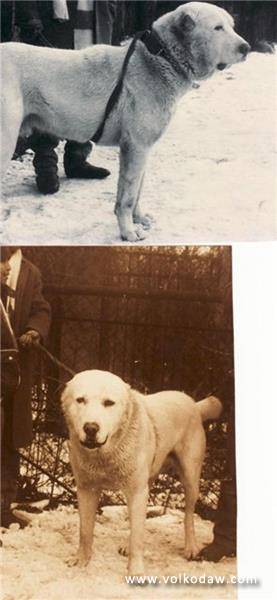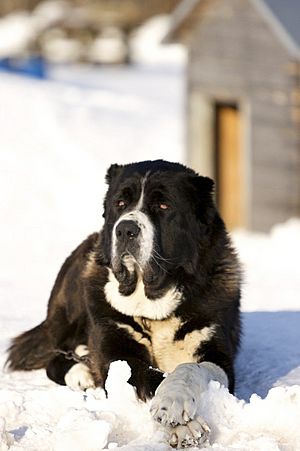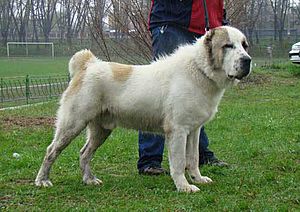Central Asian Shepherd Dog facts for kids
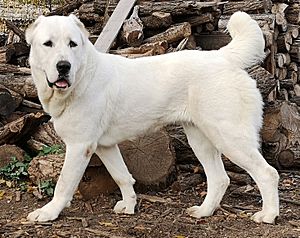
Central Asian Shepherd
|
|||||||||||||||||||||||||||||||||
| Other names | Alabai Boribasar Tobet Chuponi Central Asian Ovcharka Volkodav |
||||||||||||||||||||||||||||||||
|---|---|---|---|---|---|---|---|---|---|---|---|---|---|---|---|---|---|---|---|---|---|---|---|---|---|---|---|---|---|---|---|---|---|
| Origin | Central Asia | ||||||||||||||||||||||||||||||||
|
|||||||||||||||||||||||||||||||||
|
|||||||||||||||||||||||||||||||||
| Domestic dog (Canis lupus familiaris) | |||||||||||||||||||||||||||||||||
The Central Asian Shepherd Dog, also known as the Alabay or Turkmen Wolf-Hound, is a large, strong livestock guardian dog breed. For a long time, these dogs were used to guard sheep and goat herds. They also protected homes and people. In 1990, Turkmenistan officially recognized the Turkmen Wolf-Hound as a dog breed.
Contents
History of the Central Asian Shepherd
These dogs first came from a large area in Central Asia, between the Ural River, Caspian Sea, Asia Minor, and the border of China. You can still find these original Central Asian Shepherds in countries like Kyrgyzstan, Tajikistan, Turkmenistan, Kazakhstan, Afghanistan, and Uzbekistan.
In Turkmenistan, this dog is a symbol of national pride. A gold statue of the Alabay was even put up in 2020. Some Central Asian Shepherds guard livestock, some protect their owners, and some are used in traditional dog fighting events in these regions. This breed is similar to other large guardian dogs from the area, like the Georgian Shepherd and Kangal Shepherd Dog.
Studying the Breed
Russian biologists and scientists started studying these local dogs in the 1700s. After the Communist revolution, the Soviet government wanted strong working dogs for the army. They brought the best Central Asian Shepherds to Russia for military and guard duties. Over time, this practice affected the dog population in their home countries. New breeds were brought in, leading to mixed-breed dogs. Purebred Central Asian Shepherds mostly remained with herders, dog lovers, and on farms.
However, the Central Asian Shepherd Dog population is still strong. They continue to produce high-quality dogs known for their working skills. Today, it's common for breeders to trade dogs and bloodlines between Russia, other former Soviet countries like Ukraine and Belarus, and the original Central Asian countries.
Different Types of Central Asians
This breed includes many different types of dogs. They can vary in size, color, head shape, and hair length. Central Asian Shepherds often form social groups, with each dog having different duties. Because of this, puppies with different working qualities can be born in the same litter.
Purebred Central Asians have unique body features. For example, they have very flexible joints, special "false ribs", a specific head shape, and a very strong neck with a large dewlap (loose skin under the throat). Their eyes are often described as expressive and intelligent.
Traditional Dog Fights
For a long time, traditional dog fighting was a common practice in the places where these dogs came from. However, these fights were not cruel like some modern pitbull fights. Herders from the same area would meet once a year. They would have their strongest male sheep guardian dogs fight to see who was the leader. This was more about showing who was dominant than hurting each other.
Most dogs would size each other up and the weaker dog would often leave, accepting defeat. Dogs rarely got seriously hurt, usually just minor scratches. Only the true leaders would have a real fight to decide the strongest. This was a small part of their lives compared to their daily job of facing predators and venomous snakes.
Modern commercial dog fights are very different from these old traditions. They have different rules and involve different breeds. Most Central Asian Shepherds used in modern commercial fights come from specific "fighting lines." Breeders usually know if their dogs come from these lines. Dogs from fighting backgrounds might be very aggressive towards other dogs. It's important to know if a dog will only be aggressive to strange dogs on its territory or if it will attack any dog, even those in its own family group.
Modern Roles
Central Asian Shepherds are still used as livestock guardians, though not as much as before. These dogs protect against human intruders and are very territorial. They are generally safe with children and show love and respect for older people. They protect small animals from predators and are very gentle with their family members.
Dogs used for personal protection or other working roles often come from livestock guardian dogs. Russian dog experts have carefully bred them for specific working skills. These dogs are very good at obedience, protecting property, and personal protection. They are also very intelligent, making them good house dogs. They learn basic house rules easily and treat their owners with great respect, just like their ancestors treated herders.
These dogs have been very successful in protecting sheep around the world. Guard dogs need to work as a team to protect sheep from predators. Dogs that are too aggressive cannot be part of the pack and would not pass this important test for their original purpose.
Central Asian Shepherd dogs can come from working lines, fighting lines, or livestock guardian lines. Their behavior will often match their background. A simple check of their family tree and talking to the breeder can tell you what to expect from a dog. Pure show line Central Asians are rare because most dog registries require working tests before breeding.
What Central Asian Shepherds Look Like
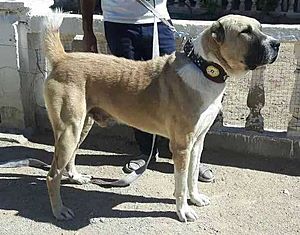
This breed is a strong dog, larger than average, with great power. They are independent, curious, and alert, but also calm. The dog is usually as long as it is tall at the shoulders, or slightly longer. They have short or medium-length hair with a thick undercoat.
Their ears are often cropped (cut short), and their tails are docked (cut to a medium length). This is not done in countries where these cosmetic surgeries are illegal. Common colors include black and white, different shades of fawn (from almost white to deep red), and brindle (striped). Some have a black mask on their face.
Their head is very solid, without a strong stop (the dip between the forehead and snout). The neck is low-set, short, and has a dewlap. Their body is wide and well-proportioned, with flat muscles. Their ribcage looks very long because of their developed false ribs. Their legs are straight, with strong bones and good angles. The leg bones must be in proportion and should not look too short. The back end is broad. They typically move with a gallop, but they can also trot for hours without getting tired.
The President of Turkmenistan, Gurbanguly Berdymukhamedov, wrote a book about the Alabay. In 2017, he gave a puppy named Verni to Russian President Vladimir Putin as a birthday gift.
Popularity of the Alabay
In Turkmenistan, a special National Holiday of the Turkmen Alabay was started in 2021. In April 2021, the first "Brave Turkmen Alabay of the Year" beauty contest was held in Turkmenistan as part of this holiday. The contest is now held every year on the last Sunday of April.
The main office for the International Association "Turkmen Alabay" is in Ashgabat, Turkmenistan's capital. To help dog breeding in Turkmenistan and share their success with the world, the "Turkmen Alabay" Association publishes a magazine called "Türkmeniň nusgalyk alabaýy" ("Exemplary Turkmen Alabay").
The Alabay as a Symbol
Alabay dogs were the mascot for the 2017 Asian Indoor and Martial Arts Games. The image of the Alabay is also on the state medals "People's Dog Breeder of Turkmenistan" and "Honored Dog Breeder of Turkmenistan." In November 2020, a large 15-meter (about 49 feet) Alabay monument was opened in Ashgabat.
Working Tests for Central Asian Shepherds
The Central Asian Shepherd is a working dog breed. Different dog organizations have rules and suggestions to help keep these dogs' natural abilities strong. This includes special tests to find out a dog's natural qualities and training levels or titles that show what the dog can learn.
In Russia, the National Breed Club created a temperament test. This test shows if a dog is willing and able to protect a place. They also have titles for Obedience (like OKD) and Protection (like ZKS or KS) for dogs from Russia and other countries in that region. There are many other types of tests and training titles, from simple to very complex.
In European countries, breed clubs often have fewer requirements. Common dog sports like Schutzhund are not always a perfect fit for a livestock guardian dog. Some European Union countries have created special tests for large dog breeds to check a dog's overall calmness and stability, like The Dog Mentality Assessment test in Sweden.
Fight tests are common in countries where the breed is still in its original, natural state. Even though commercial dog fights have a bad reputation, these fight tests are meant to show a dog's willingness and ability to fight predators. In places with many sheep farms, livestock can be lost to feral dogs and wolf-dog hybrids. Livestock guardian dogs must be able to protect the sheep from these threats. The fight tests were made to help keep this important breed trait.
Ban
The Central Asian Shepherd Dog is banned in Denmark.
Images for kids
-
Vladimir Putin with Verni as a puppy in 2017.
See also
 In Spanish: Pastor de Asia Central para niños
In Spanish: Pastor de Asia Central para niños
- Afghan Shepherd Dog
- Armenian Gampr Dog
- Caucasian Shepherd Dog
- Georgian Shepherd Dog
- List of dog breeds
- Pshdar Dog
- Sarabi Mastiff


